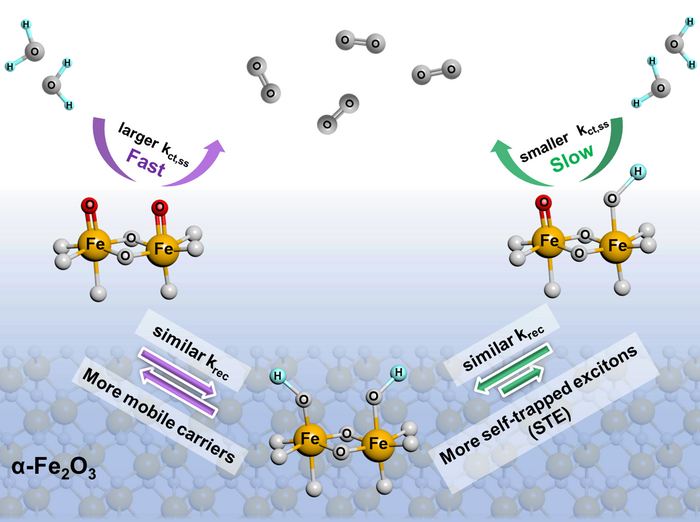This study is led by Prof. Yuchao Zhang (Key Laboratory of Photochemistry, Chinese Academy of Sciences).

Credit: ©Science China Press
This study is led by Prof. Yuchao Zhang (Key Laboratory of Photochemistry, Chinese Academy of Sciences).
Photoelectrochemical (PEC) water oxidation reaction has attracted considerable attention in recent years because of its importance in solar energy conversion. For such a sluggish four-hole and four-proton transfer reaction in a long timescale of ms–s, more and more studies have shown that the accumulation of multiple surface-trapped holes (e.g., high-valent iron oxo on hematite surfaces) or “oxidizing equivalents” is a prerequisite for efficient PEC water oxidation process. Previous PEC water oxidation studies commonly apply high potentials (>1.2 VRHE) to achieve this key. But how to complete multi-hole transfer under low bias (near the onset potential) remains unknown.
Recently, Zhang’s research group studied the important role of excitation energy in the multi-hole accumulation process. PEC characterizations and rate law analysis showed that the UV excitation could significantly boost the accumulation of multiple surface-trapped holes, thereby cathodically shifting the onset potential by 220 mV and improving the PEC water oxidation activity by one order of magnitude. Subsequent bulk transport dynamics and surface charge-transfer kinetics demonstrated that compared with the visible-light excitation, the UV excitation reduced the formation probability of self-trapped excitons and resulted in ~3 to 5-fold increase of surface holes, which accounted for the promoted multi-hole accumulation process. These advantages enable the UV excitation to contribute about 40% to the total photocurrent under 1 solar illumination, even though its energy only occupies 6% of the incident light. This mechanism was also applicable to boost other multi-hole catalysis (such as the oxidation of thioether and nitrite) under low bias.
See the article:
Boosting multi-hole water oxidation catalysis on hematite photoanodes under low bias
https://engine.scichina.com/doi/10.1007/s11426-022-1527-9
Journal
Science China Chemistry
DOI
10.1007/s11426-022-1527-9




